
John Hough James (1800-1881) was an American lawyer, banker, railroad builder, scientific farmer and stockbreeder, legislator, politician, editor, lecturer and writer. James was a pioneer in the development of western banking and transportation.

John Hough James (1800-1881) was an American lawyer, banker, railroad builder, scientific farmer and stockbreeder, legislator, politician, editor, lecturer and writer. James was a pioneer in the development of western banking and transportation.
James was born in Waterford, Virginia to Levi James and Rachel Hough. Levi was the son of Joseph James, born on board a ship traveling from Wales to America. During his life, Levi was a shopkeeper, a merchant of river commerce, a bank director and a prominent citizen in the developing city of Cincinnati. Rachel Hough was the daughter of John Hough and Lydia Hollingsworth and was descended from the large and prominent family of Samuel Hough in Bucks County, Pennsylvania. John Hough James spent his early childhood in Northern Virginia. When he was thirteen, his family moved to the rugged frontier of southern Ohio, landing at Cincinnati November 4, 1813. [1]

In Cincinnati, Levi James became a trustee of Lancaster Seminary school which John Hough and his brother David Allen James attended. Levi and other parents of children needing further education helped form Cincinnati College. John was in the first graduating class, eventually earning a Master's degree from the school. He married Abigail Bailey, the daughter of Revolutionary War printer Frances Bailey, in 1825 and the couple moved to Urbana, Ohio. They had four children including a son, John Henry James who served as a Union soldier in the Civil War. [2]

James grew to adulthood in the era of railroad expansion and the development of the telegraph. He embraced the sweeping changes that were taking place during his lifetime and he used the accelerating rate of communication and the expanding reach of transportation to strengthen connections between himself and his environment. [3] The primary conduit between James and the world was the process of reading, writing and dialogue. James was already an active letter writer by the time he was a teenager. In school, he was an energetic debater and an admired actor. [4] As a young adult, James circle of correspondents came to include men and women among family, friends and acquaintances. He was central to the formation of a literary group, the "Phoenix Club," which included his future wife, Abigail. [5] He read, wrote and taught language classes at Cincinnati College.
The significance of James' interaction with his classmates, correspondents, club members, family and friends is that he deeply engaged the literature of his age in the development of his relationships, professional life and personal lifestyle. As a reader he absorbed the accumulated knowledge of renowned thinkers. As a discussant he analyzed the information he read, and as an author he expressed his own conclusions and observations, thus contributing to the ongoing literary conversation. Noted historians and educators, David Thelen and Roy Rosenzweig have said their subjects "built narratives that enabled them to shape the courses of their own and others' lives." [6]

In a similar way, James and the other contributors deliberately wielded composition as a tool and a resource for personal and interpersonal development. This is illustrated in relation to James, himself, by his first diary entry:
1 January 1821 - With the beginning of a New Year- I commence a journal of ephemeral events.- a kind of record of my hours of application and of rest - to look at in after days.- trusting that the contemplation of what I have done may serve to remind me of what I can do and the consideration of what I have not may stimulate me to what I should do. [7]
As a prominent figure, James was asked to speak publicly on many occasions. These presentations involved political issues, national events, local initiatives and business dealings. He began collecting and composing material for a written history of Ohio in the 1830s, but later abandoned the project after much work when he was advised of another such project that would be published before his was ready. In later years, James bought the Urbana Free Press and renamed it the Urbana Union. He had long been a contributor of articles and editorials for many publications including the National Intelligencer. He participated a wide range of educational projects from the support of Cincinnati College to the development of Urbana University. He accumulated a tremendous personal library that he shared with his family, and which became a treasured heirloom for several generations. "The main feature of the James home was, of course, James' library. Over the years he accumulated a wealth of books and a massive array of historical materials. .. no record exists as to either the full extent or content of Mr. James' remarkable collection, except that it literally consumed the entire house."
James' support for Urbana University was the culmination of a lifelong commitment to education for men and women. His wife, Abby James, supervised the planting of trees on the campus and did much of it herself. The course of study at the school was divided into three departments: Language, Science and Philosophy (which included the "Science of Correspondence.") James participated in school administration as well as various educational functions and the James family library was an important reference resource for students at the university. In 1854, the university's first graduating class was composed of three boys and one girl.
John Hough James was interested in nearly every aspect of business and commerce that he encountered. He read for law and began to practice soon after graduating from college. He also worked for his father's river shipping business in various capacities. In his lifetime he owned a bank, a newspaper and several farming properties. He was treasurer and president of the Mad River and Lake Erie Railroad, helping to build one of the earliest railroads in the country. He experimented with numerous other enterprises including mule breeding, silk production, real estate speculation, railroad and canal building, river shipping and more. Although he seems to have been very financially successful throughout his entire life, James was central to many failed business ventures in banking, canal building and railroading.
James was a friend of both Henry Clay and William Henry Harrison and met with Whig leaders in the General Assembly of Ohio and in the United States Congress in his work as a lawyer and politician. From early political conversations with William Henry Harrison, John Hough James was a staunch Whig and an outspoken campaigner for his party. He supported Harrison, Henry Clay and a host of other candidates as a matter of principle. He spoke publicly in criticism and in support of particular issues related to presidential and national politics and he served as an Ohio State Senator from 1835 to 1839. He remained a Whig long after there was no Whig party. [8]
In 1828, James was appointed as quartermaster for a division of the local militia in Urbana, Ohio. He was made Lieutenant-Colonel in 1829 and retained the rank of Colonel until he died. Although he did not serve actively in the Civil War, he helped manage the formation and disposition of units from Ohio and, like many others, he helped provide material support for the Union. John's son, John Henry James, graduated from the Kentucky Military Institute and served in the Twenty-sixth Ohio Volunteer Regiment. He fought in several important actions and recorded his experience of the Battle of Murfreesboro in a brief diary.
It would be difficult to prove that any one thing that John Hough James did was unique, or even particularly interesting. Everything done by him had been done by someone else, often to greater effect. The importance of his life and his legacy is the stunningly comprehensive and inclusive character he exhibited. His tremendous interest in obtaining and providing education, his enthusiastic participation in dozens of business ventures, his intense political engagement and his perpetual correspondence made him a landmark in the development of a modern American. Throughout all of this activity, he maintains his intellectual relationship with Abigail, he promotes inclusiveness as a feature of his personal philosophy and his religion, and he demonstrates an unusual, if limited, degree of gender-blindness in his dealings with a variety of other people.

William Henry Harrison was an American military officer and politician who served as the ninth president of the United States from March 4 to April 4, 1841, the shortest presidency in U.S. history. He was also the first U.S. president to die in office, causing a brief constitutional crisis since presidential succession was not then fully defined in the U.S. Constitution. Harrison was the last president born as a British subject in the Thirteen Colonies and was the paternal grandfather of Benjamin Harrison, the 23rd U.S. president.

Loveland is a city in Hamilton, Clermont, and Warren counties in the southwestern part of the U.S. state of Ohio. The population was 13,307 at the 2020 census. Considered part of the Cincinnati metropolitan area, Loveland is located near exit 52 off Interstate 275, about 15 miles (24 km) northeast of the Cincinnati city limits. It borders Symmes, Miami and Hamilton townships and straddles the Little Miami River. Once a busy railroad town, Loveland is now a major stop along the Little Miami Scenic Trail.
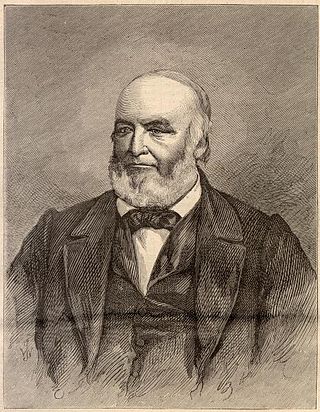
John Brough was a War Democrat politician from Ohio. He served as the 26th governor of Ohio during the final years of the American Civil War, dying in office of gangrene shortly after the war concluded.

William Dennison Jr. was a Whig and Republican politician from Ohio. He served as the 24th governor of Ohio and as U.S. Postmaster General in the Cabinet of President Abraham Lincoln during the American Civil War.
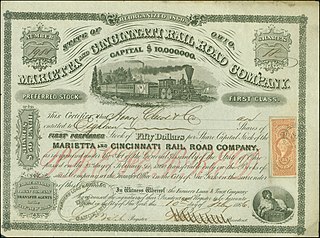
The Marietta and Cincinnati (M&C) was one of five important east-west railroads of southern Ohio; it was later absorbed by the Baltimore and Ohio Railroad (B&O). Its original route ran from Marietta through Vincent, Athens, Hamden, Chillicothe, Greenfield, Blanchester, and Loveland. It had two main branches: Blanchester to Hillsboro, which was originally part of the Hillsboro and Cincinnati Railroad; and Hamden to Portsmouth, Ohio, originally part of the Scioto and Hocking Valley Railroad.

Whiggism or Whiggery is a political philosophy that grew out of the Parliamentarian faction in the Wars of the Three Kingdoms (1639–1651). The Whigs advocated the supremacy of Parliament, and opposed granting freedom of religion, civil rights, or voting rights to anyone who worshipped outside of the Established Churches of the realm. The Whigs ultimately conceded strictly limited religious toleration for Protestant dissenters, while continuing the religious persecution of Catholics and staunchly opposing a "Papist" on the English throne, especially James II or his descendants. It is associated with early conservative liberalism.

Lewis Davis Campbell was an American politician as a U.S. Representative for Ohio. Over his political career he was elected as a Whig, Republican, Know Nothing, and Democrat.

During the American Civil War, the State of Ohio played a key role in providing troops, military officers, and supplies to the Union army. Due to its central location in the Northern United States and burgeoning population, Ohio was both politically and logistically important to the war effort. Despite the state's boasting a number of very powerful Republican politicians, it was divided politically. Portions of Southern Ohio followed the Peace Democrats and openly opposed President Abraham Lincoln's policies. Ohio played an important part in the Underground Railroad prior to the war, and remained a haven for escaped and runaway slaves during the war years.
Woodward Career Technical High School is a public high school located in the Bond Hill neighborhood of Cincinnati, Ohio, United States. It is part of the Cincinnati Public School District.
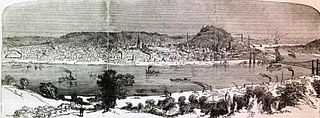
During the American Civil War, the Ohio River port city of Cincinnati, Ohio, played a key role as a major source of supplies and troops for the Union Army. It also served as the headquarters for much of the war for the Department of the Ohio, which was charged with the defense of the region, as well as directing the army's offensives into Kentucky and Tennessee.
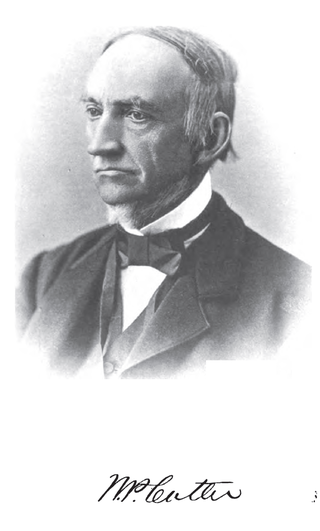
William Parker Cutler was an American railroad executive and politician who served as a U.S. Representative from Ohio for one term from 1861 to 1863.
Colonel Milton Alexander McRae was an American newspaper publisher who co-founded the Scripps-McRae League of Newspapers and United Press International. The son of Helen and Duncan Van McRae, he was born in Detroit, Michigan in the United States.
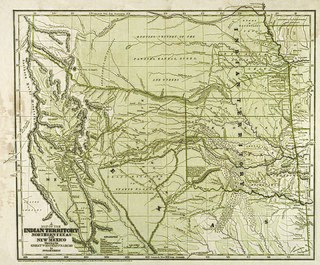
Events from the year 1844 in the United States.
Events from the year 1853 in the United States.

Brigadier General William Harvey Gibson was a Republican politician from Ohio. He resigned from the Ohio State Treasurer's office in disgrace after failing to report his predecessor for theft, but redeemed his reputation in war. He was brevetted Brigadier General of the Union Army's 49th Ohio Volunteer Infantry during the American Civil War.
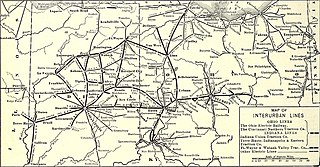
The Ohio Electric Railway was an interurban railroad formed in 1907 with the consolidation of 14 smaller interurban railways. It was Ohio's largest interurban, connecting Toledo, Lima, Dayton, Columbus, and Cincinnati. At its peak it operated 617 miles (993 km) of track. Never financially healthy, the company went bankrupt in 1921 and was dissolved into its constituent companies.
John A. Corwin was a Democratic politician and jurist from Ohio, United States. He was elected to the Ohio Supreme Court and ran unsuccessfully for the United States House of Representatives.

Kerry Coombs is an American football coach who is the special teams coordinator and cornerbacks coach at the University of Cincinnati. Previously, Coombs was an assistant coach for the Tennessee Titans of the National Football League (NFL) in 2018 and 2019 and the defensive coordinator for the Ohio State Buckeyes from 2020 to 2021.
Stephen Satterly L'Hommedieu was an American publisher and railroad executive and who served as president of the Cincinnati, Hamilton and Dayton Railroad Company.